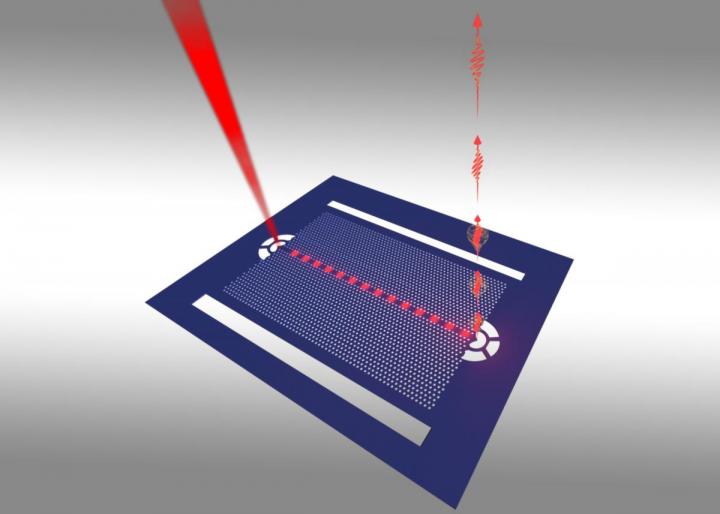The size of a quantum dot determines its emission wavelength, but no two quantum dots have exactly the same size and shape when they are created. To enable quantum dots to emit single photons with the same wavelength, and positioned less than 1 millionth of a meter apart, the researchers patterned strain using local phase transitions to selectively tune individual quantum dots that were embedded in a photonic architecture. The patterning was implemented using in-operando laser crystallization of a thin HfO2 film “sheath” on the surface of a GaAs waveguide.
 Schematic of a nanoscale structure called a photonic crystal waveguide that contains quantum dots that can interact with one another when they are tuned to the same wavelength. Courtesy of Chul Soo Kim, U.S. Naval Research Laboratory.
“Instead of making quantum dots perfectly identical to begin with, we change their wavelength afterward by shrink-wrapping them with laser-crystallized hafnium oxide,” researcher Joel Grim said. “The shrink wrap squeezes the quantum dots, which shifts their wavelength in a very controllable way.”
Schematic of a nanoscale structure called a photonic crystal waveguide that contains quantum dots that can interact with one another when they are tuned to the same wavelength. Courtesy of Chul Soo Kim, U.S. Naval Research Laboratory.
“Instead of making quantum dots perfectly identical to begin with, we change their wavelength afterward by shrink-wrapping them with laser-crystallized hafnium oxide,” researcher Joel Grim said. “The shrink wrap squeezes the quantum dots, which shifts their wavelength in a very controllable way.”
Using this approach, the researchers tuned multiple quantum dots into resonance within the same waveguide and demonstrated a quantum interaction through superradiant emission from three quantum dots. The team believes that precision in both wavelength and position is possible not just for two or three, but for many quantum dots in an integrated circuit, using the new technique.
“NRL’s new method for tuning the wavelength of quantum dots could enable new technologies that use the strange properties of quantum physics for computing, communication, and sensing,” researcher Allan Bracker said. “It may also lead to neuromorphic, or brain-inspired, computing based on a network of tiny lasers.”
The research was published in Nature Materials (https://doi.org/10.1038/s41563-019-0418-0).

